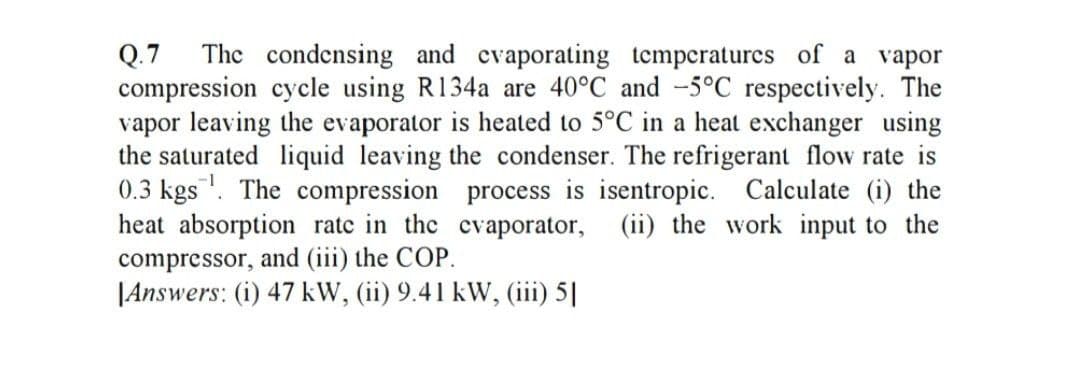Q.7 The condensing and evaporating temperatures of a vapor compression cycle using R134a are 40°C and -5°C respectively. The vapor leaving the evaporator is heated to 5°C in a heat exchanger using the saturated liquid leaving the condenser. The refrigerant flow rate is 0.3 kgs. The compression process is isentropic. Calculate (i) the heat absorption rate in the evaporator, (ii) the work input to the compressor, and (iii) the COP.
Q.7 The condensing and evaporating temperatures of a vapor compression cycle using R134a are 40°C and -5°C respectively. The vapor leaving the evaporator is heated to 5°C in a heat exchanger using the saturated liquid leaving the condenser. The refrigerant flow rate is 0.3 kgs. The compression process is isentropic. Calculate (i) the heat absorption rate in the evaporator, (ii) the work input to the compressor, and (iii) the COP.
Principles of Heat Transfer (Activate Learning with these NEW titles from Engineering!)
8th Edition
ISBN:9781305387102
Author:Kreith, Frank; Manglik, Raj M.
Publisher:Kreith, Frank; Manglik, Raj M.
Chapter10: Heat Exchangers
Section: Chapter Questions
Problem 10.17P
Related questions
Question
i need the answer quickly

Transcribed Image Text:Q.7
compression cycle using R134a are 40°C and -5°C respectively. The
vapor leaving the evaporator is heated to 5°C in a heat exchanger using
the saturated liquid leaving the condenser. The refrigerant flow rate is
0.3 kgs. The compression process is isentropic. Calculate (i) the
heat absorption ratc in the cvaporator, (ii) the work input to the
compressor, and (iii) the COP.
|Answers: (i) 47 kW, (ii) 9.41 kW, (iii 5
The condensing and cvaporating temperatures of a vapor
Expert Solution
This question has been solved!
Explore an expertly crafted, step-by-step solution for a thorough understanding of key concepts.
Step by step
Solved in 2 steps with 3 images

Knowledge Booster
Learn more about
Need a deep-dive on the concept behind this application? Look no further. Learn more about this topic, mechanical-engineering and related others by exploring similar questions and additional content below.Recommended textbooks for you

Principles of Heat Transfer (Activate Learning wi…
Mechanical Engineering
ISBN:
9781305387102
Author:
Kreith, Frank; Manglik, Raj M.
Publisher:
Cengage Learning

Principles of Heat Transfer (Activate Learning wi…
Mechanical Engineering
ISBN:
9781305387102
Author:
Kreith, Frank; Manglik, Raj M.
Publisher:
Cengage Learning